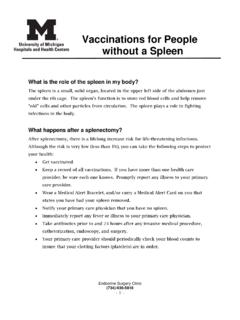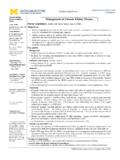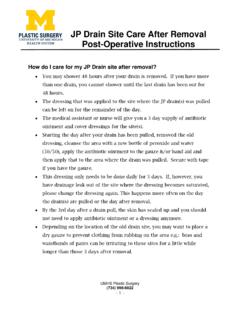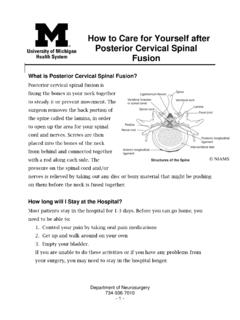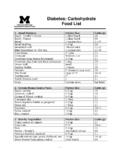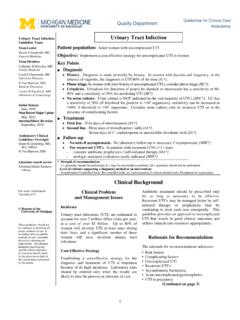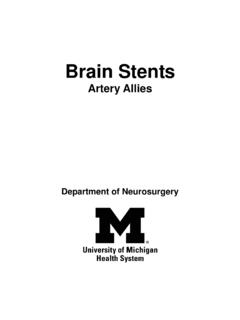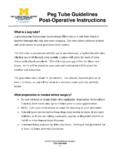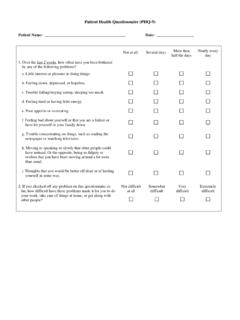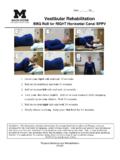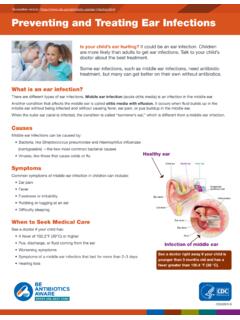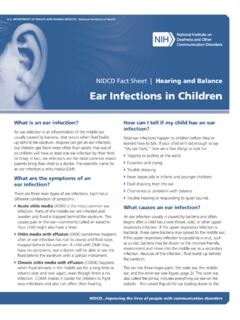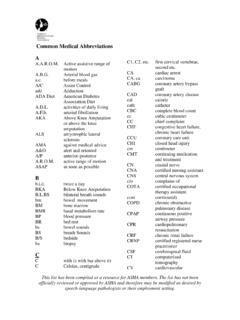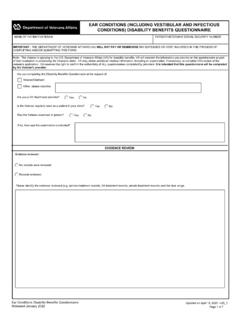Transcription of Otitis Media - University of Michigan
1 Guidelines for Clinical Care Quality Department Ambulatory Otitis Media Otitis Media Patient population: Pediatric patients (>2 months old) and adults Guideline Team Objectives: (1) Limit acute symptoms and suppurative complications caused by acute Otitis Media . (2) Maximize language development and minimize long term damage to middle ear Team leader structure associated with Otitis Media with effusion . Heather L. Burrows, MD, (3) Limit complications of antibiotic therapy including the development of antibiotic- PhD resistant bacteria. General Pediatrics Key points Team members Diagnosis R. Alexander Blackwood, MD, PhD Distinguish between acute Otitis Media (AOM) and Otitis Media with effusion (OME) (see Table 1). Pediatric Infectious Symptoms of pain or fever, together with an inflammatory middle ear effusion , are required to make a Disease diagnosis of AOM [I, D*]. James M. Cooke, MD The presence of middle ear effusion should be determined by the combined use of otoscopy, pneumatic Family Medicine otoscopy, and tympanometry when necessary [I, D*].
2 Therapy of acute Otitis Media R. Van Harrison, PhD. Medical Education Recommend adequate analgesia for all children with AOM [I, D*]. Kathryn M. Harmes, MD. Consider deferring antibiotic therapy for lower risk children with AOM [II, A*]. Family Medicine When antibiotic therapy is deferred, facilitate patient access to antibiotics if symptoms worsen ( , a "back-up" prescription given at visit or a convenient system for subsequent call-in) [I, C*]. Peter P Passamani, MD Amoxicillin is the first choice of antibiotic therapy for all cases of AOM. Pediatric Otolaryngology Children: Consultant - Dosing: < 4 years, 80 mg/kg/day divided BID; 4 years, 40- 60 mg/kg/day [I, C*] . Kristin C Klein, PharmD - Duration 5-10 days: 5 days is usually sufficient at lower cost and fewer side effects, although 10. UMH Pharmacy Services days reduces clinical failure [A*] . Consider 10-day course for children: with significant early URI.
3 Symptoms and <2 years old, with possible sinusitis, and with possible strep throat [II, D*] . Adults: either 875 mg BID x 10 days or 500 mg 2 tabs BID x 10 days [I, C*] . Updated In the event of allergy to amoxicillin, azithromycin (Zithromax) dosed at 30 mg/kg for one dose is the April, 2013 appropriate first line therapy. Interim/Minor Revision Treat AOM that is clinically unresponsive to amoxicillin after 72 hours of therapy with March, 2014 amoxicillin/clavulanate (Augmentin ES; amoxicillin component 80 mg/kg/day divided BID) for 10 days or with azithromycin (Zithromax) 20 mg/kg daily for 3 days [II, C*]. Patients with significant, persistent symptoms on high-dose amoxicillin/clavulanate (Augmentin ES) or UMHS Guidelines azithromycin (Zithromax) may respond to IM ceftriaxone (Rocephin; 1-3 doses) [II, C*]. The decision Oversight Team to use ceftriaxone (Rocephin) should take into account the negative impact it will have on local Grant Greenberg, MD, MA, antibiotic resistance patterns.
4 MHSA. R Van Harrison, PhD Therapy of OME. Children with middle ear effusions should be examined at 3 month intervals for clearance of the effusion [I, D*]. Literature search service Children with evidence of mucoid effusions or anatomic damage to the middle ear should be referred to Taubman Medical Library otolaryngology if effusion or abnormal physical findings persist for 3 months [I, D*]. Children with apparent serous effusions should be referred to otolaryngology if effusion persists for 6. months and there is evidence of hearing loss or language delay [I, D*]. For more information call GUIDES: 734-936-9771 Children with an asymptomatic middle ear effusion (no apparent developmental or behavioral problems) can be followed without referral [I, B*]. Parents of all children with OME should be informed about approaches to maximize language Regents of the development in a child with a possible hearing loss [I, C*].
5 University of Michigan Decongestants and other nasal steroids have been shown not to decrease middle ear effusions [IIIA*] . Other Issues Addressed in the Text These guidelines should not be construed as including all proper Special Populations Special Situations methods of care or excluding other acceptable methods of Otitis Media in infants 0 8 weeks old Primary care management of tympanostomy tubes care reasonably directed to Otitis Media in children with chronic illnesses Cerumen removal obtaining the same results. The ultimate judgment regarding any Otitis Media in adults Care of otorrhea and acute Otitis externa. specific clinical procedure or * Strength of recommendation: treatment must be made by the physician in light of the I = generally should be performed; II = may be reasonable to perform; III = generally should not be performed. circumstances presented by the Level of evidence supporting a diagnostic method or an intervention: patient.
6 A=randomized controlled trials; B=controlled trials, no randomization; C=observational trials; D=opinion of expert panel. 1 UMHS Otitis Media Guideline, April 2013. Table 1. Diagnostic Definitions Acute Otitis Media (AOM) (ICD-9-CM code ). Middle Ear effusion (MEE) - demonstrated by pneumatic otoscopy, tympanometry, air fluid level, or a bulging tympanic membrane plus Evidence of acute inflammation opaque, white, yellow, or erythematous tympanic membrane or purulent effusion plus Symptoms of otalgia, irritability, or fever Otitis Media with effusion (OME) (ICD-9-CM code ) MEE without symptoms of AOM with or without evidence of inflammation Table 2. Treatment of Acute Otitis Media Antibiotic Cost a Presentation Associated Treatment and Antibiotic Dose Generic Brand Initial Presentation Bulging or erythematous tympanic membrane with MEE and: no symptoms (no fever, irritability, ear pain) See OME (Table 3). minor symptoms (sleeping and acting well).
7 - < 24 months & unilateral AOM Observation option; recommend ibuprofen - > 24 months & unilateral or bilateral AOM Observation option; recommend ibuprofen - < 24 months & bilateral AOM Start ibuprofen + amoxicillin (see dosing below). moderate symptoms (fever, significant pain, Start ibuprofen + amoxicillin otalgia present > 48 hours) Pediatric: Age < 4: 80 mg/kg/day divided BID x 5-10 days Age 4: 40-60 mg/kg/day div BID x 5-10 days $11 NA. (max 1000 mg/dose) $28 NA. Adult: either 875 mg BID x 10 days or 500 mg 2. tabs BID x 10 days $9 NA. If amoxicillin sensitivity azithromycin (Zithromax) c $8 NA. Pediatric: 30 mg/kg x 1 dose (max 1500 mg). Adult: 500mg daily x 3 days $38 $52. $17 $50. severe symptoms (AOM with apparent Strongly consider laboratory testing to rule out systemic toxicity) serious coexistent disease. Consider other etiologies. Ceftriaxone (Rocephin). Pediatric: 50-75 mg/kg/day IM x 1-3 days (max 1000 mg/day) $55-70b $113b Adult: 1-2g IM/IV daily x 1-3 days $70-102b $113-340b Follow up If symptom relief Pediatrics: Follow up in 3 months.
8 Adults: Follow up is not required if symptoms completely relieved. If symptoms persist > 3 days following Either amoxicillin/clavulanate (Augmentin ES). initiation of treatment with amoxicillin, Pediatric: 80 mg/kg div BID x 10 days (max 3 g) $59 $130. reevaluate. If middle ear findings persist: Adult: 875/125mg BID x 10 days $26 $214. or azithromycin (Zithromax) c Pediatric: 20 mg/kg daily for 3 days (max 1500 mg) $48 $52. Adult: 1 g daily for 3 days $32 $149. If significant symptoms continue to persist Ceftriaxone (Rocephin; See Severe Symptoms . despite high dose amoxicillin/clavulanate or above). azithromycin, reevaluate and treat: Recurrent AOM. AOM more than 14 days after finishing See Initial Presentation above. (If antibiotic successful antibiotic treatment, assume that therapy is indicated: amoxicillin.). new AOM is unrelated to previous AOM. Follow up See Follow up above Note: Evidence is limited for optimal drug, dosage, or duration of therapy for AOM in adults.
9 A Cost = Average wholesale price based -10% for brand products and Maximum Allowable Cost (MAC) + $3 for generics on 30-day supply, Amerisource Bergen item Catalog 5/12 & Blue Cross Blue Shield of Michigan Mac List, 5/12. b Cost also includes $30 (charge at UM Health System) for performing each injection. c The FDA issued a warning that azithromycin could cause potentially fatal irregular heart rhythm in some patients. At-risk patients include those with a slower-than-normal heartbeat, with potassium or magnesium deficiencies, and those using medications to treat existing heart arrhythmia. 2 UMHS Otitis Media Guideline, April 2013. Table 3. Diagnosis and Treatment of Otitis Media with effusion Evaluate tympanic membranes at every well child and sick child exam when feasible. Perform pneumatic otoscopy or tympanometry when possible. Record findings. If the tympanic membrane (TM) is occluded with cerumen, consider removal.
10 If MEE, determine nature of effusion . Attempt to distinguish between effusions that are likely to be transient, such as serous or purulent effusions and effusions likely to be persistent or associated with significant morbidity, such as mucoid effusions. For likely transient effusions, reevaluate at 3 month intervals, including a screen for language delay. In the absence of anatomic damage or evidence for developmental or behavioral complications, continue to observe at 3 month intervals. If complications appear to arise, refer to otolaryngology. For apparent mucoid effusions or effusions that appear to be associated with anatomic damage, such as adhesive Otitis or retraction pockets, reevaluate in 4-6 weeks. If abnormality persists, refer to otolaryngology. No antibiotics are indicated. Decongestants and nasal steroids are not indicated. If symptoms arise, see AOM (Table 2). Table 4. Risk factors for Developmental Difficulties Hearing loss independent of OME.
